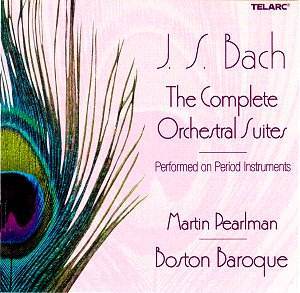We can usually count
on Martin Pearlman for intelligent,
dynamic "period" performances of Baroque
and Classical repertoire, but this set
of the Bach Suites is oddly variable.
The freshly reconsidered
Second Suite, the best "period" rendition
of it I've heard, is the set's highlight.
The opening of the Ouverture,
played at a sprightly alla breve,
has a real French-overture feeling;
in the ensuing Allegro, Christopher
Krueger's unexpectedly dark-hued Baroque
flute stands out in crisp relief against
the strings. Pearlman, taking his cue
from the key of B minor, offers an unusually
serious "take" on the ensuing sequence
of shorter movements. The Rondeau
is meditative, the Polonaise
and its Double grave and dignified,
the Menuet sombrely elegant;
yet the underlying dance pulse remains
clear in each case.
The First Suite, while
less explicitly imaginative, is equally
successful. The bright, reedy ensemble
sound is appealing, and the tempi are
fluidly motile. (In all the slow introductions,
incidentally, Pearlman's brisk speeds
furnish the written rhythms with a lively
"snap," thus rendering the entire double-dotting
controversy irrelevant.) The Courante
and Gavottes thrive on phrasing
which shapes whole bars as "upbeats"
to others, thus building a long line
rather than bogging down in individual
beats. The Menuets are too fast
for dancing, but suggest the proper
stateliness.
Trouble creeps in thereafter.
After the surging majesty of its opening,
the Ouverture of the Third Suite
chugs along smoothly and a bit uneventfully.
The strings play the famous Air
without vibrato, but thoughtful layering
of dynamic levels, both within and between
phrases, convey the sense of a singing
line. There's an uncomfortable moment
at 0:39 of the Bourrée,
where the trumpets enter a bit sluggishly
- as if anticipating the ritard on the
repeat - which should have been redone.
The Fourth Suite, alas,
is more or less a wash. The rhythms
feel less strongly grounded than elsewhere:
the Ouverture's running triplet
theme sounds shapeless, and the start
of the Bourrée, while
together, is mushy. This sequence also
occasions Pearlman's single clear tempo
miscalculation, where he unwillingly
has to slow down for the bassoon's running
figures, which the Baroque bassoon doesn't
project with the modern instrument's
clear definition anyhow. The Menuets
flow too casually, and even the Réjouissance
lacks zest.
The album presents
the suites in chronological order of
composition (4-1-3-2) rather than in
straight numerical order, adding insult
to injury by leading off with the weakest
performance. (The intent was presumably
to separate the two "big" suites and
so avoid a surfeit of D major.) Telarc's
sound is unexceptionable.
Stephen Francis
Vasta


